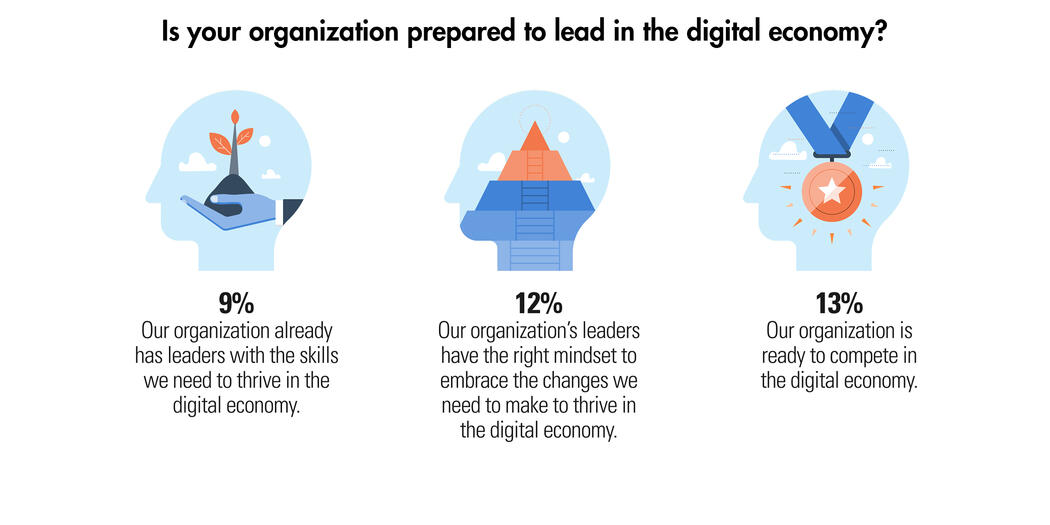The digital economy is here to stay, and the frontiers seem limitless. But are you and your organization poised to harness its full potential and come out on top, or are you sailing without a compass on a cloudy night? Here are five insights from MIT Sloan Management Review to help you navigate the sometimes treacherous waters.
Technology changes faster than organizations do
You’ve heard of Moore’s Law — the doubling of microchip processing power every two years — but what about George’s Law, the First Law of Digital Innovation?
That’s what MIT Sloan senior lecturer and research scientist George Westerman calls his observation that technology changes quickly, but organizations change much more slowly. A technological system, Westerman writes, follows the instructions given to it and can more or less be relied upon to carry them out exactly. It’s much harder to achieve that level of efficiency in human systems.
“Digital transformation is more of a leadership challenge than a technical one. Large organizations are far more complex to manage and change than technologies. They have more moving parts, and those parts, being human, are much harder to control,” Westerman writes. “While it’s relatively straightforward to edit a software component or replace one element with another, it’s nowhere near as easy to change an organization.”
Westerman said a successful digital transformation requires changing the organization’s vision in a way the workforce can get behind, cleaning up legacy systems, and changing how collaboration happens within the organization.
A ‘mindset gap’ can hamper digital transformation
Sure, you can teach business leaders the tech skills necessary to be competitive in the digital economy, but it’s a much heavier lift to get them to embrace the right mindset to thrive in it. And the wrong mindset leads to plenty of blind spots, writes MIT senior lecturer Douglas Ready.
A global executive survey reveals that few managers and leaders strongly agree their organizations are ready to take on the challenges brought by digitalization.
Specifically, there are four blind spots that can spell trouble for a business trying to carry out a digital transformation: strategic, cultural, human capital, and personal.
Strategically, leaders need to shift to a mindset that embraces the effects of platforms and networks, rather than trying to win through optimizing organizational capabilities, Ready writes. Culturally, they need to stop talking the talk about digital and start walking the walk. “If we fail to get beyond just talking about building agile systems and processes, or stimulating breakthrough innovation, or developing resiliency in our work environments, we could easily develop cultural blind spots by growing increasingly out of touch,” he writes.
On human capital, it’s time to implement policies and practices aimed at attracting high-value talent; people who want their talents recognized and appreciated, want to work for leaders that help them grow, and want to work at companies that are making the world a better place. Can you say you have those in place?
On a personal level, “If you don’t know what you don’t know, it’s relatively easy to create personal blind spots that will impede your own growth and development, perhaps simply because you are unaware of a skill, behavior, or mindset gap,” Ready writes.
Digital savvy leads the way
It pays for a company to have a digitally savvy board of directors.
Having three or more members that understand through experience how digital technologies will impact company success yields 17% higher profit margins, 38% higher revenue growth, a 34% higher return on assets, and 34% higher market cap growth, according to MIT Center for Information Systems Research scientists Peter Weill and Stephanie Woerner and colleagues.
But only 24% of companies with more than $1 billion in revenue had such boards. Organizations can get up to speed by bringing on new board directors with digital experience and taking the initiative to educate current members on digital trends and topics, the researchers write.
Consumers can be digital innovators too
Traditionally, companies are the ones innovating and bringing new, novel products to market. But consumers can innovate just as effectively, especially if the current market isn’t satisfying their needs, writes MIT Sloan professor Eric von Hippel and his colleagues.
The way consumers innovate differs drastically from the way producers do. One example: A group of health care professionals and computer scientists worked together on their own time and with their own money to develop an artificial pancreas for diabetics and then shared the innovation with the wider community for free.
Another instance: A computer scientist developed a web-based platform for those suffering from Crohn’s disease; the community worked together to triangulate which treatments were effective and which were problematic. Von Hippel writes such patient-driven innovation is taking place “on a massive scale.”
“What is striking about both of these cases is that neither commercial medical producers nor the clinical care system offered a solution that these patients urgently needed. Motivated patients stepped forward to develop solutions for themselves, entirely without commercial support,” the authors write.
Digital brings both promise and pitfalls
Today, just about everything can be connected to the internet, from a thermostat that lets you turn your home air conditioning down two degrees from your office to a refrigerator that sends you an alert when your milk is about to go bad. It’s all part of a melding of the digital and physical worlds called the “internet of things.”
But, MIT Sloan research affiliate Mohammad Jalali writes, as convenient as these gadgets can be, they also harbor a dark side — one that could put your personal data, privacy, or safety at risk. And businesses need to get ahead of those risks to ensure their products make it to market and remain competitive. The more popular an internet of things product becomes, the more appealing it is to hackers, and the higher the risk of an incident and subsequent loss of consumer trust.
“If a new product experiences a publicized cyber incident, it may never get off the ground, even if the security issue gets resolved. This is a prime example of why IoT developers cannot simply focus on marketing and innovation. Security needs to be addressed proactively, even if it requires a considerable investment of resources in earlier stages,” Jalali writes.




